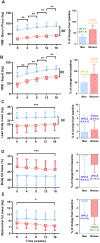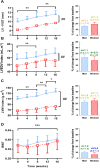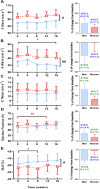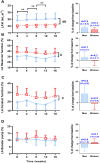Impact of a 16-week strength training program on physical performance, body composition and cardiac remodeling in previously untrained women and men
- PMID: 38895874
- PMCID: PMC11170668
- DOI: 10.1002/ejsc.12033
Impact of a 16-week strength training program on physical performance, body composition and cardiac remodeling in previously untrained women and men
Abstract
Even if more and more women are involved in strength-training (ST) programs in fitness centers, studies on strength gain, body composition, and cardiac remodeling were mainly conducted in men and whether they are similar in women remains to be explored. In this context, the aim of our study was to assess the effect of a supervised ST program on strength gains, body composition, and cardiac remodeling in previously untrained women and men. 17 healthy and previously untrained young women and 17 young men participated in a supervised 16-week ST program built according to the recommendation of the American College of Sports Medicine in terms of intensity, and strictly using similar volume and intensity in both groups. Strength performance, body composition, and cardiac remodeling were evaluated every 4 weeks. Cardiac adaptations were assessed using resting echocardiography, including regional 2D-Strain analysis of the left atrium and ventricle (LA and LV, respectively). Despite lower values at baseline, women exhibited similar or even higher strength gains compared to men. ST induced a decrease of body and abdominal fat mass and an increase of lean body mass in both groups. Similar cardiac remodeling was observed in women, and women, including an early and progressive LV and LA enlargement throughout the ST program, without any alteration of LV diastolic and systolic functions. These findings underlie that ST programs are highly suitable for women to enhance their strength performance and their cardiovascular health.
Keywords: body composition; cardiovascular health; strength‐training; women.
© 2024 The Authors. European Journal of Sport Science published by Wiley‐VCH GmbH on behalf of European College of Sport Science.
Conflict of interest statement
There is no conflict of Interest to declare.
Figures





Similar articles
-
Association between muscle strength gains and biventricular cardiac remodeling in response to high-intensity resistance training in healthy untrained males: a longitudinal study.BMC Sports Sci Med Rehabil. 2025 May 7;17(1):116. doi: 10.1186/s13102-025-01165-8. BMC Sports Sci Med Rehabil. 2025. PMID: 40336139 Free PMC article.
-
Effects of a 20-Week High-Intensity Strength Training Program on Muscle Strength Gain and Cardiac Adaptation in Untrained Men: Preliminary Results of a Prospective Longitudinal Study.JMIR Form Res. 2023 Oct 24;7:e47876. doi: 10.2196/47876. JMIR Form Res. 2023. PMID: 37874630 Free PMC article.
-
Comparison of two lower-body modes of endurance training on lower-body strength development while concurrently training.J Strength Cond Res. 2009 May;23(3):979-87. doi: 10.1519/JSC.0b013e3181a0629d. J Strength Cond Res. 2009. PMID: 19387377 Clinical Trial.
-
Resistance Exercise Dosage in Men with Prostate Cancer: Systematic Review, Meta-analysis, and Meta-regression.Med Sci Sports Exerc. 2021 Mar 1;53(3):459-469. doi: 10.1249/MSS.0000000000002503. Med Sci Sports Exerc. 2021. PMID: 32890199 Free PMC article.
-
Effects of Small-Sided Soccer Games on Physical Fitness, Physiological Responses, and Health Indices in Untrained Individuals and Clinical Populations: A Systematic Review.Sports Med. 2020 May;50(5):987-1007. doi: 10.1007/s40279-019-01256-w. Sports Med. 2020. PMID: 31989457
Cited by
-
Sex differences in absolute and relative changes in muscle size following resistance training in healthy adults: a systematic review with Bayesian meta-analysis.PeerJ. 2025 Feb 25;13:e19042. doi: 10.7717/peerj.19042. eCollection 2025. PeerJ. 2025. PMID: 40028215 Free PMC article.
References
-
- American College of Sports Medicine. 2009. “American College of Sports Medicine Position Stand. Progression Models in Resistance Training for Healthy Adults.” Medicine & Science in Sports & Exercise 41(3): 687–708. - PubMed
-
- Armstrong, Timothy , and Bull Fiona. 2006. “Development of the World Health Organization Global Physical Activity Questionnaire (GPAQ).” Journal of Public Health 14(2): 66–70. 10.1007/s10389-006-0024-x. - DOI
-
- Beaumont, Alexander , Grace Fergal, Richards Joanna, Hough John, Oxborough David, and Sculthorpe Nicholas. 2017. “Left Ventricular Speckle Tracking‐Derived Cardiac Strain and Cardiac Twist Mechanics in Athletes: A Systematic Review and Meta‐Analysis of Controlled Studies.” Sports Medicine 47(6): 1145–1170. 10.1007/s40279-016-0644-4. - DOI - PMC - PubMed
MeSH terms
Grants and funding
LinkOut - more resources
Full Text Sources

